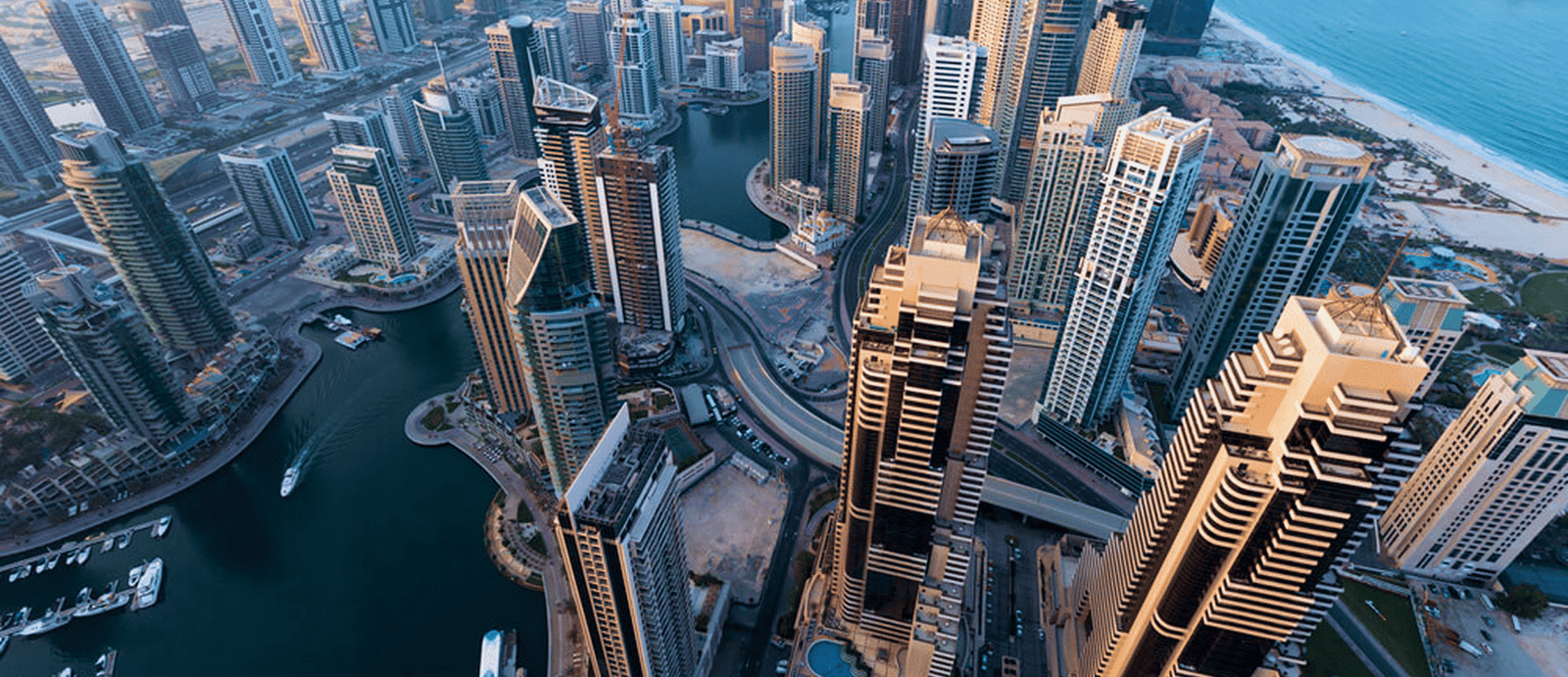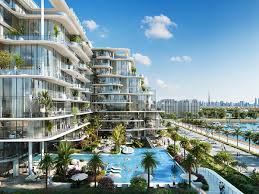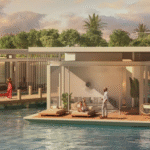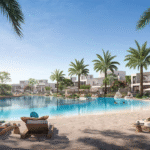Now Reading: Rental Property Tax in Dubai: What Landlords Need in 2025
-
01
Rental Property Tax in Dubai: What Landlords Need in 2025
Rental Property Tax in Dubai: What Landlords Need in 2025

Table of Contents
Rental Property: Imagine owning a sleek waterfront apartment in Dubai, the skyline twinkling outside your window, with rental income flowing into your account free from the heavy taxes that landlords face in cities like London or New York. In 2025, Dubai’s real estate market remains a haven for landlords, offering 100% foreign ownership and a tax-friendly environment that outshines global hubs where taxes can erode 15-45% of rental profits.
The UAE’s dirham, pegged to the U.S. dollar, eliminates currency risk, and residential sales dodge 5% VAT, saving thousands. With a 5% population surge, 25 million tourists, and 8-12% price appreciation expected, Dubai’s rental properties deliver 4-6% yields, surpassing London (2-4%) or New York (3-4%). Properties over $545,000 qualify for a 10-year Golden Visa, while smaller units offer 2-year residency perks.
This guide explores the 2025 rental property tax landscape for landlords, highlighting five prime projects Palm Jumeirah Sky Villas, Dubai Marina Coastal Lofts, Bluewaters Horizon Residences, Jumeirah Bay Pearl Apartments, and World Islands Sapphire Villas and key tax rules to maximize returns in Dubai’s vibrant market.
Why Dubai’s Rental Market Is a Landlord’s Dream
Dubai’s rental market thrives in iconic areas like Palm Jumeirah, Dubai Marina, Bluewaters Island, Jumeirah Bay, and The World Islands, located 15-30 minutes from Dubai International Airport via Sheikh Zayed Road or by boat. With 58% non-resident buyers from countries like the UK, India, and Russia driving 94,000 property transactions in the first half of 2025, the city boasts low vacancy rates (2-3% vs. 7-10% globally) and 4-6% rental yields.
A $2 million apartment yielding 5% ($100,000 annually) is tax-free for individual landlords, versus $55,000-$70,000 elsewhere after income taxes. Zero capital gains tax saves $80,000-$112,000 on a $400,000 profit. No annual property taxes save $20,000-$40,000 yearly, unlike New York (1-2%) or London (council tax up to 2%).
Residential sales avoid 5% VAT ($100,000), and the 9% corporate tax doesn’t apply to individual landlords. Free zone companies save $1,000-$30,000 annually, and small business relief waives corporate tax for revenues under $816,000 until December 31, 2026. With high demand from expatriates and tourists, Dubai’s rental market feels like a financial sanctuary.
The tax-free rental income makes being a landlord here feel like a golden opportunity.
Tax Rule 1: No Personal Income Tax on Rentals
Individual landlords in Dubai pay no personal income tax on rental earnings, a stark contrast to the U.S. (up to 37%) or UK (up to 45%). A $1.5 million Dubai Marina Coastal Loft yielding $60,000-$90,000 annually keeps every dirham, versus $37,800-$49,500 elsewhere.
This applies to both long-term leases, registered via Ejari ($54-$136 annually), and short-term rentals, which require Department of Tourism and Commerce Marketing (DTCM) registration ($408-$816 annually) and boost yields by 10-20% due to tourist demand. This tax-free structure lets landlords reinvest profits or enjoy a higher lifestyle.
Keeping all your rental income feels like a monthly financial win.
Tax Rule 2: Corporate Tax and Free Zone Benefits
While individual landlords face no income tax, companies managing rentals may incur a 9% corporate tax. However, setting up a Qualified Free Zone Person (QFZP) free zone company in areas like Dubai Marina or Bluewaters saves $1,000-$30,000 annually. For a $3 million Palm Jumeirah Sky Villa yielding $120,000-$180,000 annually, a QFZP saves $10,800-$16,200 compared to a mainland company. Setup costs ($2,000-$5,000) and annual fees ($1,000-$3,000) are minimal, and small business relief waives corporate tax for revenues under $816,000 until 2026. Non-compliance risks fines up to $136,125, so professional setup is essential.
This free zone strategy feels like a clever way to keep profits high.
Tax Rule 3: No Annual Property Taxes
Dubai imposes no annual property taxes, unlike New York (1-2%) or London (council tax up to 2%). For a $2 million Jumeirah Bay Pearl Apartment, landlords save $20,000-$40,000 yearly, which compounds for reinvestment or lifestyle upgrades. Maintenance fees ($5,000-$25,000 annually) and a 5% municipality fee on rentals ($2,400-$12,000) are the primary ongoing costs. This absence of property taxes makes owning rental properties feel lighter than in other global cities.
Saving thousands yearly feels like a gift that fuels your wealth.
Tax Rule 4: VAT Considerations for Landlords
Residential rental income is exempt from 5% VAT, unlike commercial rentals. For a $1.2 million Bluewaters Horizon Residence yielding $48,000-$72,000 annually, landlords avoid $2,400-$3,600 in VAT. However, off-plan property purchases may incur 5% VAT on developer fees ($20,000-$80,000), recoverable via Federal Tax Authority (FTA) registration ($500-$1,000). Short-term rental operators must register for VAT if annual revenue exceeds $102,041, charging 5% on bookings but claiming input tax credits on expenses like utilities or DTCM fees. Proper VAT compliance ensures maximum savings.
Navigating VAT feels like unlocking a secret to leaner operations.
Tax Rule 5: U.S. and International Tax Benefits
U.S. landlords can deduct depreciation ($21,818-$181,818), maintenance ($5,000-$35,000), and mortgage interest on Schedule E, saving thousands annually. For a $3 million World Islands Sapphire Villa, deductions could save up to $54,545 yearly. Non-U.S. investors from 130+ countries with double taxation treaties avoid taxes like the UK’s 20-28% capital gains tax when selling. Zero capital gains tax in Dubai saves $60,000-$420,000 on profits from $300,000-$1.5 million. These benefits make Dubai’s rental market globally attractive.
These tax perks feel like a financial boost for international landlords.
Palm Jumeirah Sky Villas: Waterfront Luxury Rentals
Palm Jumeirah Sky Villas by Nakheel, set for completion in Q2 2025, offer 4-6% rental yields and 8-12% price growth. Featuring 4-6 bedroom villas ($3 million-$6 million), these 4,000-6,000 square foot homes boast private beaches and smart systems. A $4 million villa yields $160,000-$240,000 tax-free annually, versus $88,000-$144,000 elsewhere. With 25% growth, selling it for $5 million yields a $1 million tax-free profit, saving $200,000-$280,000 in capital gains tax. No property taxes save $40,000-$80,000 yearly, and VAT exemption saves $200,000.
Initial costs include a 4% DLD fee ($120,000-$240,000), 2% broker fee ($60,000-$120,000), and a 20/50/30 payment plan. Annual maintenance fees are $15,000-$25,000, and landlords pay a 5% municipality fee ($8,000-$12,000). A QFZP saves $40,800-$61,200 on $408,000-$612,000 in rental income. U.S. investors deduct depreciation ($72,727-$109,091) and management fees ($7,455-$14,545), saving up to $36,364. Golden Visa eligibility applies. Short-term rentals boost yields by 10-20%. Its 2% vacancy rate attracts affluent tenants.
The beachfront luxury feels like a tax-free, high-return paradise.
Dubai Marina Coastal Lofts: Modern Urban Rentals
Dubai Marina Coastal Lofts by Emaar, set for completion in Q3 2025, offer 4-6% rental yields and 8-12% price growth. Featuring 1-3 bedroom apartments ($816,750-$2.04 million), these 800-2,200 square foot units boast marina views and smart designs. A $1.2 million apartment yields $48,000-$72,000 tax-free annually, versus $26,400-$43,200 elsewhere. With 25% growth, selling it for $1.5 million yields a $300,000 tax-free profit, saving $60,000-$84,000 in capital gains tax. No property taxes save $12,000-$24,000 yearly, and VAT exemption saves $60,000.
Initial costs include a 4% DLD fee ($32,670-$81,675), 2% broker fee ($16,335-$40,838), and a 50/50 payment plan. Annual maintenance fees are $5,000-$12,000, and landlords pay a 5% municipality fee ($2,400-$3,600). A QFZP saves $12,240-$18,360 on $122,400-$183,600 in rental income. U.S. investors deduct depreciation ($21,818-$43,636) and management fees ($2,236-$5,091), saving up to $17,455. Golden Visa eligibility applies. Short-term rentals boost yields by 10-20%. Its 3% vacancy rate attracts professionals.
The urban, coastal vibe feels like a vibrant, high-return retreat.
Bluewaters Horizon Residences: Trendy Waterfront Rentals
Bluewaters Horizon Residences by Meraas, set for completion in Q4 2025, offer 4-6% rental yields and 8-12% price growth. Featuring 2-4 bedroom apartments ($1.36 million-$3.27 million), these 1,500-3,500 square foot units boast Ain Dubai views and eco-friendly designs. A $2 million apartment yields $80,000-$120,000 tax-free annually, versus $44,000-$72,000 elsewhere. With 25% growth, selling it for $2.5 million yields a $500,000 tax-free profit, saving $100,000-$140,000 in capital gains tax. No property taxes save $20,000-$40,000 yearly, and VAT exemption saves $100,000.
Initial costs include a 4% DLD fee ($54,400-$130,800), 2% broker fee ($27,200-$65,400), and a 50/50 payment plan. Annual maintenance fees are $8,000-$15,000, and landlords pay a 5% municipality fee ($4,000-$6,000). A QFZP saves $20,400-$30,600 on $204,000-$306,000 in rental income. U.S. investors deduct depreciation ($36,364-$72,727) and management fees ($3,727-$8,182), saving up to $24,545. Golden Visa eligibility applies. Short-term rentals boost yields by 10-20%. Its 3% vacancy rate attracts young professionals.
The trendy, waterfront aesthetic feels like a refreshing, high-return haven.
Jumeirah Bay Pearl Apartments: Coastal Luxury Rentals
Jumeirah Bay Pearl Apartments by a leading developer, set for completion in Q1 2026, offer 4-6% rental yields and 8-12% price growth. Featuring 2-4 bedroom apartments ($1.36 million-$3.27 million), these 1,500-3,500 square foot units boast beachfront views and community retail. A $2 million apartment yields $80,000-$120,000 tax-free annually, versus $44,000-$72,000 elsewhere. With 25% growth, selling it for $2.5 million yields a $500,000 tax-free profit, saving $100,000-$140,000 in capital gains tax. No property taxes save $20,000-$40,000 yearly, and VAT exemption saves $100,000.
Initial costs include a 4% DLD fee ($54,400-$130,800), 2% broker fee ($27,200-$65,400), and a 50/50 payment plan. Annual maintenance fees are $8,000-$15,000, and landlords pay a 5% municipality fee ($4,000-$6,000). A QFZP saves $20,400-$30,600 on $204,000-$306,000 in rental income. U.S. investors deduct depreciation ($36,364-$72,727) and management fees ($3,727-$8,182), saving up to $24,545. Golden Visa eligibility applies. Short-term rentals boost yields by 10-20%. Its 3% vacancy rate attracts coastal luxury tenants.
The beachfront, luxurious vibe feels like a prestigious, high-return sanctuary.
World Islands Sapphire Villas: Private Island Rentals
World Islands Sapphire Villas by Nakheel, set for completion in Q2 2026, offer 4-6% rental yields and 8-12% price growth. Featuring 5-7 bedroom villas ($5.44 million-$10.88 million), these 6,000-10,000 square foot homes boast private docks and panoramic views.
A $6 million villa yields $240,000-$360,000 tax-free annually, versus $132,000-$216,000 elsewhere. With 25% growth, selling it for $7.5 million yields a $1.5 million tax-free profit, saving $300,000-$420,000 in capital gains tax. No property taxes save $60,000-$120,000 yearly, and VAT exemption saves $300,000.
Initial costs include a 4% DLD fee ($217,800-$435,600), 2% broker fee ($108,900-$217,800), and a 20/50/30 payment plan. Annual maintenance fees are $20,000-$35,000, and landlords pay a 5% municipality fee ($12,000-$18,000). A QFZP saves $61,200-$91,800 on $612,000-$918,000 in rental income. U.S. investors deduct depreciation ($109,091-$181,818) and management fees ($11,182-$21,818), saving up to $54,545. Golden Visa eligibility applies. Short-term rentals boost yields by 10-20%. Its 2% vacancy rate attracts ultra-high-net-worth tenants.
The private island luxury feels like an elite, high-return escape.
Costs of Owning Rental Properties in Dubai

Buying a $3 million property incurs a 4% DLD fee ($120,000), 2% broker fee ($60,000), and a 10% deposit ($300,000). Flexible payment plans like 50/50 or 20/50/30 spread costs, with 50-70% paid during construction. Annual maintenance fees range from $5,000-$35,000, and landlords pay a 5% municipality fee ($2,400-$18,000). Short-term rentals require DTCM registration ($408-$816), while long-term leases need Ejari registration ($54-$136). Off-plan purchases may incur 5% VAT ($27,225-$217,800), recoverable via FTA registration ($500-$1,000).
These costs feel like a small price for Dubai’s tax-free rental potential.
Strategies to Maximize Rental Returns
To optimize returns, use these strategies. First, target high-yield projects like World Islands Sapphire Villas (4-6%) or Palm Jumeirah Sky Villas (4-6%). Second, leverage short-term rentals in Bluewaters Horizon Residences for 10-20% yield boosts, ensuring DTCM compliance. Third, set up a QFZP free zone company to save $12,240-$91,800 annually. Fourth, recover 5% VAT on off-plan purchases.
Fifth, leverage small business relief for revenues under $816,000 until 2026. Sixth, U.S. investors should deduct depreciation, maintenance, and mortgage interest on Schedule E. Hire a property manager ($5,000-$25,000 annually) for ease. Consult a tax professional for compliance.
Navigating Risks for Smart Landlords
Risks include a projected oversupply of 41,000 units in 2025, potentially slowing price growth. Mitigate by choosing trusted developers like Nakheel or Emaar, verifying escrow compliance under the 2025 Oqood system for off-plan buys, and targeting high-demand projects with low vacancies (2-3%).
Ensure QFZP eligibility to avoid fines up to $136,125. Long-term leases in Jumeirah Bay Pearl Apartments ensure stability, while short-term rentals in Dubai Marina Coastal Lofts boost yields. Proximity to Dubai Marina and global demand drive value. Regular market analysis keeps you ahead.
Why These Projects Are Top Picks for Landlords
Palm Jumeirah Sky Villas offer waterfront luxury rentals, Dubai Marina Coastal Lofts deliver modern urban rentals, Bluewaters Horizon Residences provide trendy waterfront rentals, Jumeirah Bay Pearl Apartments bring coastal luxury rentals, and World Islands Sapphire Villas offer private island rentals. With 4-6% yields, 8-12% price growth, and multiple tax exemptions, these 2025 projects are top picks, offering landlords a lucrative, tax-free income stream in Dubai’s iconic rental market.
read more: Top 5 Dubai Islands Offering 100% Freehold and Tax Relief






















